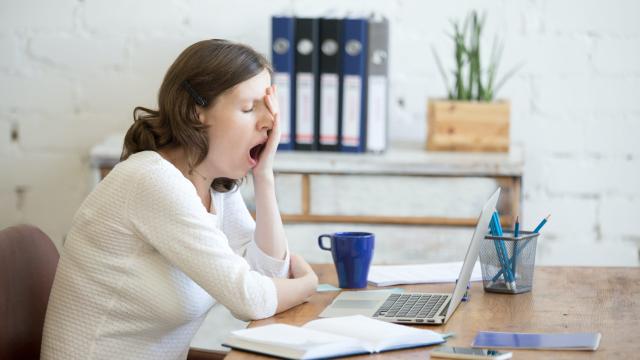Before we get started, let’s get one thing straight: this isn’t going to be a cakewalk.
When you’re really tired, working is tough no matter what you do. That said, there are ways to help make the day easier and actually get things done. You’re not going to feel bright and cheery, but you can avoid turning into a zombie. We’ve looked at quick fixes for feeling tired, but in this post we’re going to examine what you can do to help yourself during the entire day. Essentially, your goal will be to give yourself extra energy and avoid behaviours that will make your exhaustion worse. With a little bit of effort, you’ll be able to avoid passing out.
Be diligent about what (and how much) you eat and drink
When you’re tired, food is a difficult affair. You need to eat enough to provide your body with the energy it needs to get through the day, but you also need to be sure you don’t overeat (or undereat!) or you can end up feeling worse. Serve yourself whatever you would normally eat, in a normal size portion, rather than asking your poor tired brain to come up with new ideas or guess how hungry you are.
If you have multiple options for breakfast, avoid sugary foods — which sometimes cause a post-meal energy slump — and go for something filling that includes protein and fibre. (Consider a veggie omelet, or a high-protein yogurt with fruit and nuts.)
Drink plenty of water, too. If you end up getting dehydrated during the day you’ll worsen your situation as well.
Get your blood flowing with quick and simple exercises
Not all exercise will wake you up — and a long workout can wear you out — but doing small amounts of exercise during the day can help you stay alert when you’re tired. For example, do three sets of pushups with 30 second breaks in between. Do as many as you can in each set. This shouldn’t take you more than five minutes, you shouldn’t sweat too much in the process, and it’ll wake you up. If pushups aren’t your thing, check out this 10-minute workout that you can do with air squats or lunges.
Work standing up
We all know that sitting down all day is bad for us, but standing up isn’t an exciting prospect for most people, either. You’re probably used to working in chair because it’s more comfortable. When you’re tired, though, you don’t necessarily want to be uncomfortable — you just don’t want to fall asleep. This is another good excuse to work in a standing position. You may not have the desk for it, but see if there’s a way you can shift your workspace so that you can keep your monitor and keyboard at standing height. Stacks of books are your friend, or if you’re at home, find a shelf or countertop that’s an appropriate height.
Use caffeine intelligently (if necessary at all)
Caffeine is what most people use to stay awake when they’re tired, but overuse can lead to problems like headaches. If you’re a frequent coffee drinker, or you consume caffeine regularly, this section doesn’t have much news for you. You’re probably already brewing your third mug of the morning, which will help a little.
If you’re not a regular consumer, starting your day off with a reasonable amount of the stuff (around 65-100mg, about one small cup of coffee) can help prevent you from feeling more and more tired as the day goes on. This is because your active brain is constantly producing adenosine as a byproduct of its activity. When your adenosine levels are high enough, your brain knows it’s time to get some rest. Caffeine can, essentially, impersonate adenosine and bond with its receptors, putting off your brain’s job of letting you know it’s time to sleep. This works perfectly well if you’re not a constant consumer of caffeine, but won’t do so much for you if your body expects it.
The important thing to remember is to avoid caffeine in the later hours of the day, as you’re going to want to sleep eventually. Stop taking caffeine after 2 p.m. or so, or else you’ll keep yourself up late again tonight, and you’ll be rereading this article tomorrow.
Plan a well-timed power nap
Just because you’re at work doesn’t mean you can’t find a little time to sleep. Hopefully your boss is understanding enough to let you escape for 20 minutes to take a quick nap, but even if not, you can still fit one in. Napping at the wrong time of day can throw off your circadian rhythms, but if you keep that nap to 20 minutes and take it between 1:00 and 3:00 PM you can actually boost your cognitive ability without screwing with your sleep schedule. Presumably you have a lunch break, so go take a 20 minute nap in your car (or somewhere more comfortable, if you’ve got it) and take your lunch back to your desk. You can eat it there feeling a little less exhausted.
This post was originally published in June 2012 and was updated on March 15, 2021 by Beth Skwarecki with additional information, updated links, and to meet Lifehacker style guidelines.

Leave a Reply
You must be logged in to post a comment.